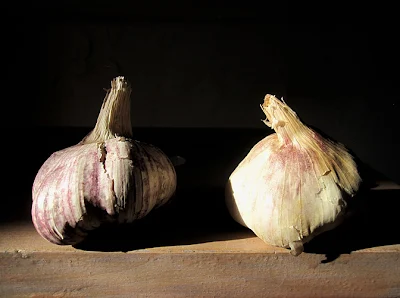Growing Garlic: Part I
Allium sativum ophioscorodon var. turban 'Tuscan'
A few of you may have noticed I've gotten a bit into garlic growing lately. In fact, I am trialing over the coming nine months a small field in upstate New York for seed production. That plot will be reclaimed as a vegetable patch by its owners late next summer, while I am, with good fortune, making preparations on another larger field somewhere else. If all grows well over the next nine months, I should have nearly 2000 heads of garlic to inspect for vigor, size, and disease. From this initial crop, I will select the best grown heads for next season's planting, beginning the process once again.
While I grow the garlic upstate, I am also trialing them at the beach farm. I want to be sure that each variety I bring to market grows well in our regions' range of USDA zones (5a-7a). In short, I am taking my time to develop the best heads of garlic that I can. If this year's seed stock proves successful, my first official garlic seed stock will be available in 2013. Growing great garlic depends on high quality seed stock and since we can't grow something from nothing, a lot is riding on the seed stock I purchased from growers in other regions of the United States.
I sourced my seed garlic from 6 different growers located throughout the United States' west and midwest regions where most of the accessible seed stock growers/retailers are located. Those climates are generally drier than ours, sometimes more temperate and sometimes not. Most seed stock growers will tell you that it can take three or so years for new garlic to acclimate to your growing region and that they make no guarantees that their garlic will do as well for you as it has done for them. Fair enough -not all growers are created equal and neither are soils or climate.
I have also planted two varieties of Hudson Valley grown, high-quality table garlic, picking only from two well-qualified organic growers whose table garlic heads appeared to be on par with my seed garlic. My interest here is to trial garlic grown in our own region in order to compare growth characteristics with its western seed stock counterparts. There is a slight risk in this practice because table garlic is not subject to the rigorous visual inspections of seed garlic in field and processing. Some diseases that affect growing quality may not affect short-term storage or culinary use, allowing those heads to be sold at market. This was a chance I was willing to take in order to trial locally grown garlic. All the garlic I grow will be inspected for good health and should any serious problems arise, the whole trial plot will be terminated.
In Part II of Growing Garlic, I will talk about the promise and pitfalls of growing grocery store or farmers' market garlic, and the difficulty in finding garlic seed when you need it most -planting time.
To be continued....
Allium sativum ophioscorodon var. porcelain 'German White' and 'Georgian Crystal'


I'm finally catching up on blog reading. How awesome that you are doing some in depth garlic growing! I look forward to reading your results and buying some garlic from you!
ReplyDelete